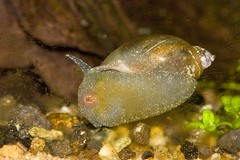Freshwater Gastropod Baby Photo

Little Spawn, originally
uploaded by: EclecticEchoes
Risking having it look like snail week... but ...
These little fresh water gastropods are from my son's aquarium. I believe that the snail is a Lymnaea sp., but I'm not a freshwater gastropod expert . It is dextral (aperture is on right with the spire pointed and oriented to see the aperture), with a thin shell that has 5-6 whorls (see below). Adults (in our tanks at least) range from 10 to 25mm while the young, fresh hatches, are about 1-2mm. They are pulmonate with no operculum, lay eggs in a gelatinous mass on the under side of broad leaved aquatic plants. The feed mainly on algae and detritus, but will preferentially go after any rotting plant leaves. The tentacles are triangular with eyes at the base. As a pulmonate this snail regularly rises to the surface to refill it's pallial lung.
Lymnae snails are simultaneous hermaphrodites, and from 2 individuals a water body can quickly be colonized. Which is precisely what happened to our larger tank when some snails or eggs made it into our tank attached to some plants. Egg masses have 20-40 individual eggs each which hatch 10-14 days after being laid.
As an informal experiment we placed one single snail in our smallest tank when it was torn down and rebuilt. All previous snails were removed and the tank torn down to bare glass removing all substrate material. Sterile sand and gravel were used as the base, to which plants were added that were wiped down and inspected for snails and egg masses. Fresh water, shrimp and fish were added to the tank and it was allowed to settle for a month, during which time the tank was inspected daily for snails or snail egg masses. After a solid month with no evidence of any snails, an 18mm adult snail was moved from an adjacent tank. Again the tank was inspected daily for snail egg masses and a snail count made. After 45 days there was still only the one introduced snail in the tank. Now (3 months later) there are 50+ snails in the tank: one 18mm adult and 49+ young snails of 2-4 mm lengths.
Sperm sequestration? Self fertilization? Both are reported in Lymnaea so it is hard for me to tell exactly, but no matter which, it does reveal a key trait that these snails use to for survival and to exploit new territory.

Lymnaea sp. Snail, originally
uploaded by: EclecticEchoes
- Kingdom
- Animalia
- Phylum
- Mollusca
- Class
- Gastropoda
- Order
- Pulmonata
- Family
- Lymnaeidae
- Genus
- Lymnaeas




















I remember coming up with the bright idea of putting a few snails in the tank when I first set up an aquarium years ago... I wonder if these are the same species. They pretty much took the tank over.
ReplyDeleteThanks for participating this week. And of course I look forward to next week's Honor an Invert day :)
Can anybody tell me why species of Thylomelania palicolarum could live in high resistant such as salinity tolerance, low temperature?
ReplyDeletePlease email me at ericchong_89@yahoo.com